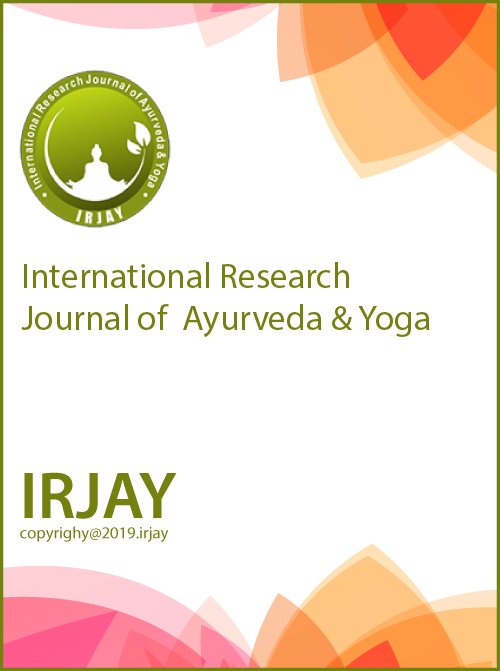Therapeutic Effects of Yoga on Varicose Veins: A Comprehensive Clinical Study
Keywords:
Ayurveda, Holistic Management, Pranayama, Varicose Veins, Vascular Health, Venous Circulation, Yoga TherapyAbstract
Background: Varicose veins, a common venous disorder, result from venous valve incompetence, leading to blood pooling and vein dilation. Conventional treatments such as compression therapy, sclerotherapy, and surgical interventions focus on symptom management rather than addressing underlying causes. Holistic approaches such as Yoga and Ayurveda offer promising complementary strategies by improving circulation, reducing venous stasis, and promoting vascular health. Aim: This study aimed to evaluate the therapeutic effects of a structured Yogic regimen on primary varicose veins among female subjects, assessing changes in venous function, symptom severity, and overall vascular health. Materials and Methods: A total of 35 female participants diagnosed with primary varicose veins from Nurpur, Kangra, Himachal Pradesh, were selected through purposive sampling. Participants underwent Doppler ultrasound testing for initial diagnosis. Aquasi-experimental pre-test and post-test design was employed, with assessments based on the revised venous clinical severity score (VCSS). Ethical approval was obtained from the Chandigarh Yoga Institutional Ethical Committee. Intervention: The intervention consisted of a structured 12-week Yogic regimen, including Asanas (Tadasana, Trikonasana, Viparita Karani, and others), Pranayama (Ujjayi, Nadi Shodhana, Bhastrika, and Bhramari), and Relaxation (Shavasana). Sessions were conducted 6 days a week for 60 min, focusing on improving circulation, reducing venous congestion, and strengthening lower limb muscles. Dietary and lifestyle modifications, such as increased fiber intake, hydration, and avoiding prolonged standing, were also incorporated. Results: The mean VCSS score significantly decreased from 7.67 (pre-test) to 1.94 (post-test), indicating substantial improvement in varicose vein symptoms. The standard deviation reduced from 1.902 to 0.617, reflecting uniform improvement among participants. A paired t-test analysis yielded a t = 16.9532 (P < 0.05), confirming the statistical significance of the intervention. Participants reported reduced pain, swelling, and discomfort, demonstrating the effectiveness of the Yogic regimen in alleviating varicose vein symptoms. Conclusion: The findings suggest that Yoga serves as an effective non-pharmacological intervention for managing primary varicose veins. Significant improvements in venous function and symptom relief highlight Yoga’s potential in vascular health management. Further studies with larger sample sizes and comparative analysis with conventional treatments are recommended to validate these findings.
Downloads
References
1. Beebe-Dimmer JL, Pfeifer JR, Engle JS, Schottenfeld D. The epidemiology of chronic venous insufficiency and varicose veins. Ann Epidemiol. 2005;15(3):175-84.
2. Evans CJ, Fowkes FG, Ruckley CV, Lee AJ. Prevalence of varicose veins and chronic venous insufficiency in the general population: Edinburgh Vein Study. J Vasc Surg. 1999;30(5):950-6.
3. Gloviczki P, Comerota AJ, Dalsing MC, Eklof BG, Gillespie DL, Monika L Gloviczki ML, Lohr JM, McLafferty RB, Meissner MH, Murad MH, Padberg FT, Pappas PJ, Passman MA, Raffetto JD, Vasquez MA, Wakefield TW. The care of patients with varicose veins and associated chronic venous diseases: Clinical practice guidelines of the Society for Vascular Surgery and the American Venous Forum. J Vasc Surg. 2011;53(5):2S-48.
4. Telles S, Singh N, Balkrishna A. Role of yoga in the management of varicose veins: A narrative review. Int J Yoga. 2017;10(1):50-6. 5. Cramer H, Lauche R, Haller H, Langhorst J, Dobos G. A systematic
review and meta-analysis of yoga for low back pain. Clin J Pain. 2014;29(5):450-60.
6. Woodyard C. Exploring the therapeutic effects of yoga and its ability to increase quality of life. Int J Yoga. 2011;4(2):49-54.
7. Jerath R, Edry JW, Barnes VA, Jerath V. Physiology of long pranayamic breathing: Neural respiratory elements may provide a mechanism that explains how slow deep breathing shifts the autonomic nervous system. Med Hypotheses. 2006;67(3):566-71.
8. Pascoe MC, Thompson DR, Jenkins ZM, Ski CF. Mindfulness mediates the physiological markers of stress: Systematic review and meta-analysis. J Psychiatr Res. 2017;95:156-78.
9. Sharma PV, Dash B. Charaka samhita. Vol. 1-4. Varanasi: Chaukhamba Sanskrit Series; 2001
10. Murthy KR. Astanga hrdayam of vagbhata. Vol. 1-3. Varanasi:
10 Sharma, et al.: Effects of yoga on varicose veins 2025; 8(3):6-11
Krishnadas Academy; 2016.
11. Singh RH, Nariya M, Kar N. Ayurveda perspectives on varicose veins and their management. J Ayurveda Integr Med. 2018;9(3):192-7. 12. Vasquez MA, Rabe E, McLafferty RB, Shortell CK, Marston WA,
Gillespie D, Meissner MH, Rutherford RB. Revision of the venous clinical severity score: Venous outcomes consensus statement: Special communication of the American Venous Forum Ad Hoc Outcomes Working Group. J Vasc Surg. 2000;52(5):1387-96.
13. Sengupta P. Health impacts of Yoga and Pranayama: A state-of-the art review. Int J Prev Med. 2012;3(7):444-58.
14. Field A. Discovering statistics using IBM SPSS statistics. 5th ed. United States: Sage Publications; 2018.
15. Satish P, Mohan R. The effects of Yoga on chronic venous insufficiency: A systematic review. J Integr Med. 2020;18(3):145-52.


